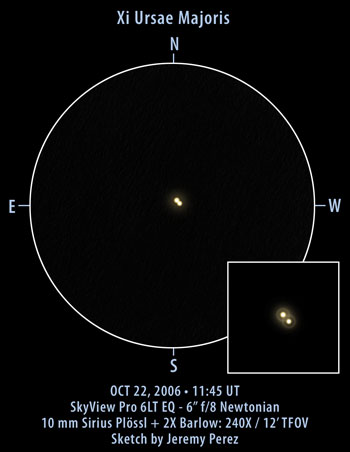
Observation Notes:
This close double consisted of two yellow-orange stars very close in brightness. The northeast component was brightest, and both stars were close to riding each other’s first diffraction rings. That would put their separation somewhere between one and two arcseconds. PA was about 235 degrees. Roughly extrapolating from the orbital predictions listed in Burnham’s Celestial Handbook, the PA should be about 240 degrees with a separation of about 1.9 arcseconds.
According to Burnham, this double was found by Sir William Herschel in May 1780. In 1804, it was announced as a physically associated pair after a PA change of 59 degrees was noted. It was the first double to have its orbit computed by M. Savary in 1828. According to T. Rakowiecki, it’s period was computed in 1938 to be 59.74 years, with periastron in 1935. This is also one of the nearest binaries to the Solar System, at 26 light years distant.
| Subject | Xi Ursae Majoris (STF 1523) |
| Classification | Double Star |
| Position (J2000) | [RA: 11:18:11 / Dec: +31:31:46]* |
| Position Angle* | 40.3° (1991) 292.1° (1997) ~240° (2006) |
| Separation* | .99″ (1991) 1.68″ (1997) ~1.9″ (2006) |
| Magnitudes* | A = 4.4; B = 4.9 |
| Spectral Types* | A = G0; B = G0 |
| Date/Time | OCT 22, 2006 – 04:45 AM MST (OCT 22, 2006 – 11:45 UT) |
| Observing Loc. | Cinder Hills Overlook, Sunset Crater National Monument, AZ |
| Instrument | Orion SVP 6LT Reflector (150 mm dia./1200 mm F/L) |
| Eyepieces/Mag. | 10 mm + 2X Barlow (240X) |
| Conditions | Clear, calm |
| Seeing | 5/10 |
| Transparency | NELM Mag 6.8+ |
| References | The Washington Visual Double Star Catalog, 1996.0 (Worley+, 1996), Tycho Double Star Catalogue (TDSC) (Fabricius+ 2002), Double stars measurements (Alzner 1998) via VizieR, and Burnham’s Celestial Handbook (Vol. 3) |
*Based on published data.
Jeremy,
Excellent work translating the eyepiece views of double stars to the screen & nice work judging the separations and PAs at the eyepiece!
I have an Excel spreadsheet I found on the web awhile ago (see sketchy details below) and calculated the orbit for 53 xi UMa (STF 1523AB / ADS 8119AB) for today and here are the figures:
Position angle: 233.18°
Separation: 1.67″
Date: 2006.910
This is *much* closer to your estimate of 235°.
Here’s a description of the file and a temporarily misdirected URL:
“Workbook created by Brian Workman (brian.workman@cox.net). Sixth Catalogue data uploaded by Tom Polakis.
Unfortunately the link above points to the wrong page. I just wrote to Tom asking him for the correct URL.
If you would like a copy of the file I work with I can send it to you.
After the star is found on the database page this line is copied to a spreadsheet to produce the calculations.
Keep up the good work!
Ben Cacace
Manhattan, NYC
Hi Ben, you know, I was thinking about where to start looking for orbital calculators for double stars last night while I was writing this post. Thanks for crunching those numbers out for me, and offering to email the file. I’d like to take you up on that offer. I think Tom lost a number of web pages a few years ago during a server crash, so that’s probably where that page went.
I hope to pick up an astrometric eyepiece sometime in 2007, and then I can nail those measurements down to something a lot more reliable.
Thanks very much for the info!
Jeremy
My pleasure. See ZIP file sent to your address for the Excel spreadsheet. The 1st sheet has the instructions. I’ve added a formula to display today’s date in the format used on the spreadsheet. A copy of the formula is in G6 on the ‘Calculator’ sheet and the date referenced is in cell F6.
Thanks for tip on Tom losing pages to a server crash. I couldn’t locate another copy of it on the web and the email address on Tom’s webpage is not active.
I look forward to your review of the eyepiece both before picking it up (as I’m sure you’re going to do the research) and after using it for a bit. 😀
>
Anytime.
Ben,
Just awesome! Thanks for sending that, it works great.
Tom is actually a member at CloudyNights.com, so you may be able to contact him by way of a private message there. Perhaps he could contact the creator of the spreadsheet and see if it would be ok to host the file elsewhere. I’d love to host it here if he was willing. I doubt it would get so much download traffic that it would kill my monthly quotas, and it’s a great resource to have available to people.
Now I’m going to mess around with it some more.
Thanks!
Jeremy